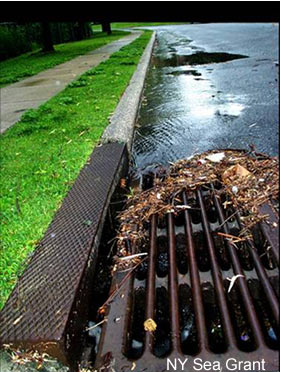What is Stormwater Pollution?
Stormwater runoff is water from rain or melting snow that does not soak into the ground. It flows from roofs, paved roads, bare soil, and sloped lawns. As it flows it can collect polltants such as fertilizers, pesticides, oils and grease, animal wastes and sediments, discharging them into storm drains. This polluted stormwater ends up in the Peconic Bay, Long Island Sound, Great South Bay, and fresh waterbodies. These pollutants restrict recreational use and degrade habitat for aquatic life resulting in bathing beach closures and shellfish harvesting restrictions.

Common stormwater pollutants and their impact
Excess Nutrients- Nitrogen and phosphorous from fertilizers, animal wastes, or failing septic systems. Excess nutrients from these sources results in algal growth, reduction of water clarity, and hypoxia (reduced oxygen levels) in receiving waters.
Synthetic Chemicals (pesticides and herbicides)- Residental and commerical applications of these chemicals can compromise the health and reporductive success of aquatic plants and animals.
Pathogens (Bacteria and Viruses)- Failing septic systems and pet waste carried by stormwater results in human health risks, shellfish harvesting restrictions and bathing beach closures.
Metals- Copper, lead, mercury, and chromium from normal vehicle wear (brake linings and tires) and leaks (gas, oil) can result in toxic sediments in aquatic habitats.
Sediments- Sediments from construction site erosion and runoff from roads and parking lots can decrease water clarity and harm bottom dwelling plants and animals.
Organic Material- Excess leaves, grass clippings and other plant material decomposing in water lowers oxygen levels, which stresses aquatic life and can result in fish kills.
Trash and Debris- Litter washed into storm drains reduces the aestthetic value of waterbodies and threatens wildife.
Hydrocarbons (oil and grease)-Fluid leaks and improper disposal results in toxic water sediments.